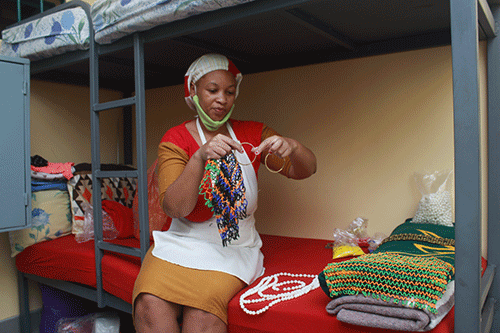Female inmates at the Windhoek Correctional facilities have found ways of keeping themselves busy, which includes basket weaving, needlework, painting, making beads and necklaces, among others.
Hailing from the Oluno Correctional Facility at Ondangwa in the Oshana region, Rachel Sebulon said she learnt basket weaving in Rundu and it has been therapeutic, as she loves making them.
The visibly beautiful pattern and colourful baskets are popular in a lot of homes where people either serve pap or place it in their lounges as a form of decoration.
“It’s a peaceful process and I love it,” said the 30-year-old.
Baking and beadwork enthusiast Rose Naledi Ninzi, a South African, who is doing a third of her fifth-term, said she learned the traits in jail.
“When I was outside, this is not something that I would be doing; however, these are now two things that I am passionate about. The system is supportive and pushes us to do better, and education is an opportunity we receive, as we want us to be skilled when we are eventually released,” shared Ninzi.
The 35-year-old mother of two said they are always encouraged to participate in programmes and are not forced, which is motivating, as they tend to do it with eagerness, since most of the activities are enjoyable and fun.
Another inmate, who has ventured into many different forms of arts, is Yvonne Peter, who does portraits, poetry, keyholders, dolls and a huge fan of planting trees.
“I will continue doing this when I am released. I love doing paintings of Nelson Mandela and drawing my 10-year-old daughter,” said the 47-year-old mother, who decided to go back to school and is busy with grade 12 classes at the facility.
She presented this reporter with two hand-signed poems, one talking about a mother’s heart and another on NCS workers.
“As I open the room, I could feel dejected emotions; faces are so different. I put on a smile and talk lively. Yes, I am putting on my brave, sometimes strict face – not at all showing my weakness or my personal feeling,” she narrated in one of her many poems.
Esmeralda Majiedt is another inmate who is being handy and doing something she loves. Alongside Peter and others, New Era found them busy knitting clothes for the inmates.
“We are the ones who made the 30 000 masks and were in charge of making the orange prison gear,” said Majiedt with a smile.
She was sentenced to an effective 17 years in prison for 404 counts of fraud charges at a local cement manufacturing company. Majiedt has so far served six years of her term and is eligible for parole if she behaves.
Stefan Theron, the senior superintendent at the Division of Mental Health and Special Needs Offenders at the Namibian Correctional Service, said their efforts are generally geared towards successful reintegration.
“One particular case is a female offender who applied entrepreneurial skills learnt in corrections to start a business selling clothes after release from corrections with support from family members. The business now serves as a source of income for the offender and her family. Generally, female offenders have better reintegration outcomes than male offenders,” pointed out Stephan.
Human Rights Watch said women all over the world have some sort of special treatment when incarcerated. Overall, women inmates have greater access to work than men inmates. At most of the women’s prisons Human Rights Watch visited, the large majority of prisoners were employed.
At the São Paulo Women’s Penitentiary, 340 out of 388 inmates were employed, 288 in workshops making items, such as notebooks, party favours and underwear – and the rest providing janitorial services within the prison,” said the group.
Human Rights Watch added: “All but one of the women confined at the Manaus women’s prison, when we visited in December 1997, were working – mostly making craft items, such as dolls.
Several women’s remuneration also tends to be much better, given the fact that women inmates generally receive at least the minimum salary mandated under the national prison law.
The rights watch group further said educational, training and cultural opportunities are somewhat less abundant but are still more easily available than in the men’s facilities.
- psiririka@nepc.com.na


